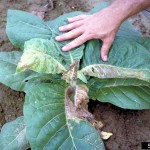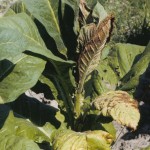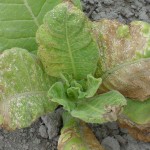Tomato Spotted Wilt Virus (TSWV)
There are no cultivars resistant to this disease.
Pictures provided by William C Nesmith, University of Kentucky Research and Education Center, bugwood.org, Robert M. McPherson, University of Georgia, bugwood.org and J. Michael Moore, University of Georgia, bugwood.org
Symptoms of spotted wilt vary according to the age of the plant at the moment of infection, environmental conditions and the part of the plant that is infected. Infections can occur from seedling stage through maturity. Tomato Spotted Wilt Virus may stunt the growth of infected plants. The symptoms are normally more severe on one side of the infected plants and in the apical bud, which may be distorted and bend in one direction or another. Young leaves show yellowish spots which can turn into necrotic spots of reddish-brown color. Tissue necrosis along midribs is also a common characteristic of spotted wilt. When infections occur close to flowering, ring spots may develop along the stem, with dark streaks on one side of the plant.
Spotted wilt is caused by the TSWV virus, which is transmitted by very small insects, thrips.
Damages can be considerable, and may cause the plant to die. The later the infection takes place, the smaller the damage. If infections occur close to, or at flowering, there will be small losses.
There are no cultivars resistant to this disease and, therefore, preventive measures should be taken, particularly in previously affected areas.
To prevent the disease, plants that host thrips should be eliminated from areas close to seedbeds, greenhouses and tobacco fields. Thrips can survive in several weeds, especially in broad leaf species. The application of preventive insecticides to control the insect from seedbed to field is of fundamental importance.


